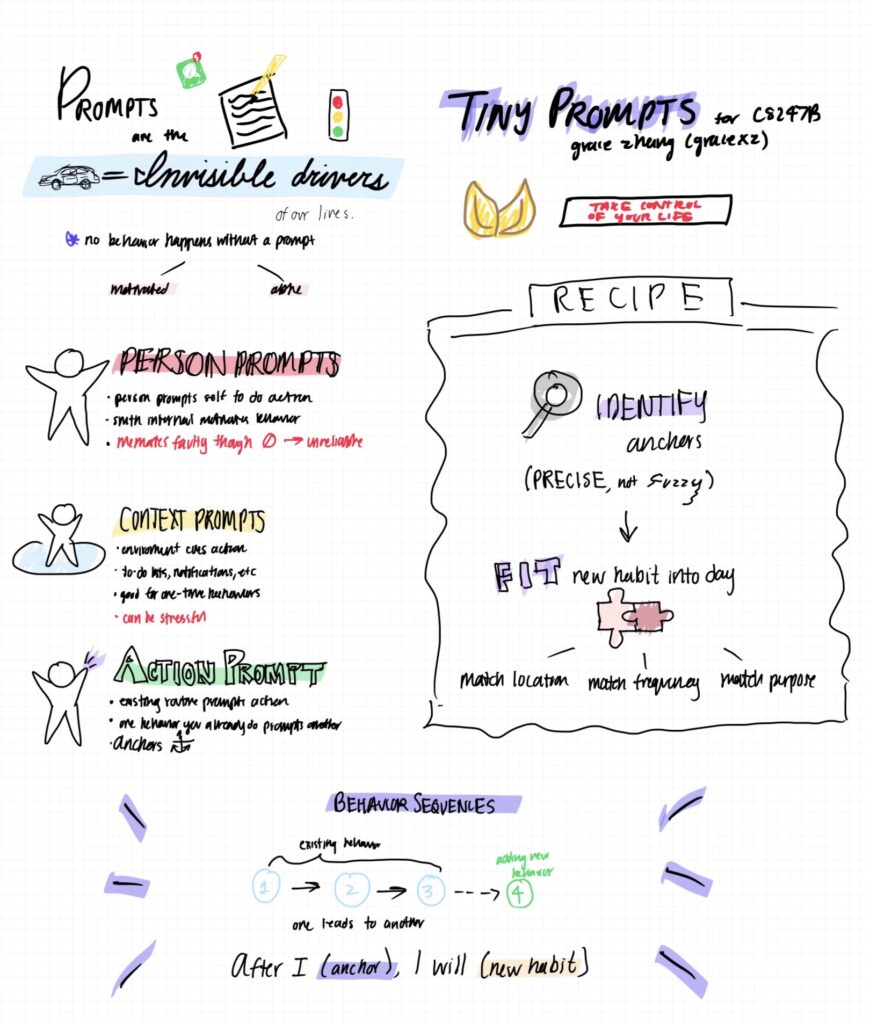Before this class, I had only one course experience with HCI, which was through CS147 last quarter. However, I was taking this course simultaneously with CS347, and I thought that the two classes informed each other pretty well. Also, I did have some informal experience with product design my sophomore year, in which I created a personal portfolio of pet projects that explored interface redesigns.
In CS247B, I really enjoyed learning about ways we can change behavior such as through nudging or habit association, and thought that it could be more helpful if the content could focus more on the behavior change aspect of design and how behavior change informs every step of the design project. For tools and methods, I think I will definitely use free-listing again in future teamwork as I found it particularly helpful in engaging with many ideas from every member, see from new perspectives, and merge ideas with efficiency. It was also interesting to see how through free-listing, most people of a team converge on the same idea or combination of ideas without ever having discussed verbally and explicitly which ideas they preferred.
The project experience allowed me to learn how to adapt to a team dynamic that I have never encountered before. I was used to working synchronously as a team outside of class through long meetings where we work on separate tasks but in one room. In this case, I found that team members preferred working asynchronously and communicating frequent updates as well as discussing new ideas and edits through our group chat. After adapting to this format of collaboration, the team dynamic felt better, and we were able to work together as a team of 3 to bring the project across the finishing line.
I really enjoyed learning about tools needed to go from needfinding to a solution. In 147, this was done through how might we’s and brainstorming ideas, but I found that connection circles, feedback loops, personas, journey-mapping, and 2×2 charts are just as – if not more – helpful. While the ethical discussions we had were interesting and brought up important considerations that we should think about, I wished there could be a more formal method in which we can apply takeaways to future work. Also, I realized that many, if not all, teams ended up doing a mobile/web application with figma prototype, which makes sense as figma prototypes are the most time efficient, and that it was very difficult to encompass every stage of the design process within 10 weeks. I did enjoy dabbling into a bit of everything, but just wished that topics/themes were more organized and that more outside resources were provided for those who want to delve deeper.
For ethical considerations from a personal viewpoint, to nudge users towards reducing unintentional phone usage in bed in the morning, our application employs a solution that asks users to pick applications they will use the next morning (like a todo list). This will allow users to act on their true goals more than they would in the morning when all they want is to go back to sleep. This is an acceptable nudge because it makes users think about intentional phone usage and it is a way for users to commit to the goals they have set in the past. We do so in a non-aggressive way, such that users can still use other apps (or snooze), but these unhappy paths are more distant and less easy-to-access. This strategy is not manipulative because we are transparent about our goals and features during onboarding, where we explain the solution and assume that users who want the same things for themselves are the ones that will end up using the app. Another ethical consideration is privacy. We share all friend’s streaks and the users’ streaks as well, but this might lead to abusers tracking another user’s sleep routine and induce activities or patterns that might harm the user. To mitigate this in the future, I think we could introduce some sort of visibility toggle, but this might compromise the social accountability aspect of the app. When faced with a similar situation in which the effectiveness of the solution might compromise ethics/privacy, I will discuss tradeoffs and look for effective solutions that lie outside of social through more user studies and assumptions testing.


